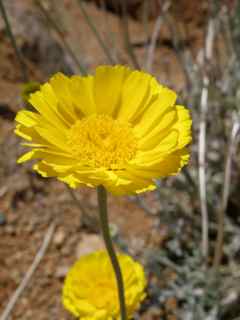 Native Plant Identification - January 16, 2013 Jeff Schalau, Agent, Agriculture & Natural Resources University of Arizona Cooperative Extension, Yavapai County We have two University of Arizona Cooperative Extension offices in Yavapai County: one in Camp Verde and another in Prescott. In case you didn’t know, these are places where you may bring plant samples, insects, soil, photos, and ask questions related to gardening and landscaping. We have a small army of Master Gardener volunteers ready and waiting to assist you. Please come and visit us! Our Camp Verde Office is near the Justice Facility (jail and courthouse) and open M-Th between 9 am and 4 pm and the Prescott office is on the Rodeo Grounds (previously the fairgrounds) and has the same hours, but is also open on Friday. Both offices are closed between noon and 1 pm. Our website, http://extension.arizona.edu/yavapai, has the addresses, maps, and contact information. Our services are free and we look forward to serving you. Many of our customers bring plant samples in for identification. Often they are weeds, but an increasing number of residents are interested in native plants. Plant identification can be challenging when a customer brings in only a leaf, twig, or young plant that has not yet flowered. For identification of herbaceous (non-woody) plants, it is important to include a flower and fruit (seed pod) with your sample and the entire plant, including roots, can also be helpful in identification. Many woody plants can be identified by their leaves, twigs, and bark, but flowers and fruit are also very helpful in identification. In 2007, a group of Yavapai County Master Gardeners came together to begin work on the Yavapai County Native and Naturalized Plant Database. Photos were taken of native plants over a two-year period to capture the plants’ seasonal changes in appearance. Initially, the website focused on native and naturalized cacti, shrubs, succulents, trees, vines and some of the common grasses of the Prescott area. The site now is being expanded to include more trees, shrubs, grass species, herbaceous perennials from other elevations of Yavapai County. The database currently has photos and descriptions of 408 plants and it continues to grow. Most recently, the team has been added over 200 forbs (small, flowering, non-woody, broadleaf plants). Along with grasses, these can be very challenging to identify. Master Gardener, Sue Smith, is the leader of the Yavapai County Native and Naturalized Plant Database project. Sue has a keen interest in native plants and is retired from eBay where she worked in database management and programming. What better way to combine one’s passion for natives with technology to create an educational tool for “native plant nerds” (that is NOT a derogatory term). Several other Yavapai County Master Gardeners are contributing photos and developing plants descriptions for the database. Others involved may be familiar to readers. Sedona resident, Max Licher, has contributed photos and technical advice. Max is very active in the Verde Valley and is often consulted by agencies and land managers for plant identification. John Kava, formerly with the U of A V Bar V Ranch Experiment Station and currently with the Natural Resource Conservation Service, has also provided technical assistance and is an ace at native plant identification. Doug Tolleson, U of A V Bar V Ranch Range Management Specialist, and I also provide technical advice and support the project in a variety of ways. So, what makes this project different from other native plant identification resources? This team tried to design it for the everyday person rather than plant taxonomists. Doug Tolleson and I sometimes call this project “Blue Collar Plants”. For example, users can search the database by entering flower, leaves, stems, and/or seed characteristics. The great part is there are drawings of the characteristics next to the search check boxes so you don’t need to know technical terms (but you will learn them by using the database). The search returns photos of the plant having those characteristics. There are also descriptions of the major plant communities of Yavapai County and other resources. The next time you find a plant you don’t recognize, go to the Yavapai County Native and Naturalized Plant Database at: http://cals.arizona.edu/yavapaiplants/ and search for it. I have also included some other plant identification resources with the on-line version of this column (the web address is below). Happy botanizing! Follow the Backyard Gardener on Twitter – use the link on the BYG website. If you have other gardening questions, call the Master Gardener help line in the Camp Verde office at 928-554-8999 Ext. 3 or e-mail us at cottonwoodmg@yahoo.com and be sure to include your name, address and phone number. Find past Backyard Gardener columns or provide feedback at the Backyard Gardener web site: http://cals.arizona.edu/yavapai/anr/hort/byg/. Additional Plant Identification Resources USDA Plants http://plants.usda.gov SEINet - Southwest Environmental Information Network http://swbiodiversity.org/seinet/ Common Plants of the Verde Valley & Sedona, Doug Von Gausig's Plant Photos and Descriptions http://www.naturesongs.com/vvplants/ |